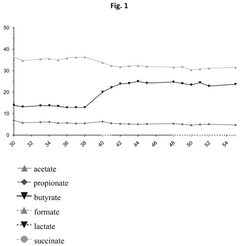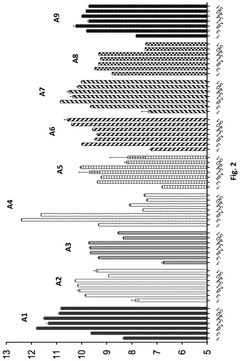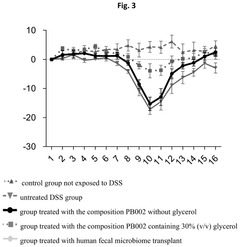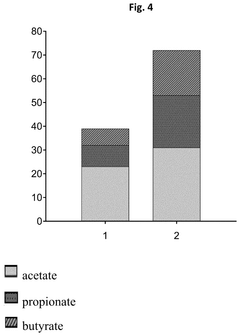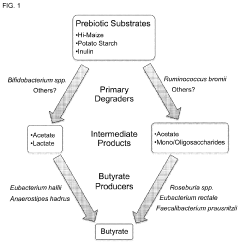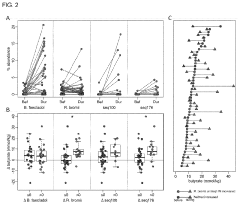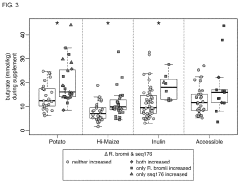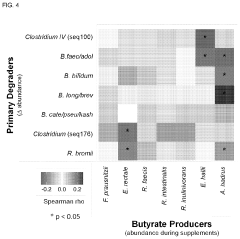How to Increase Butyrate-Producing Bacteria?
Research on Butyrate-Producing Bacteria: Background and Objectives
Butyrate-producing bacteria have gained significant attention in recent years due to their crucial role in maintaining gut health and overall well-being. These microorganisms, primarily found in the human colon, produce butyrate as a metabolic by-product of dietary fiber fermentation. Butyrate, a short-chain fatty acid, serves as the primary energy source for colonocytes and plays a vital role in maintaining intestinal barrier function, reducing inflammation, and regulating immune responses.
The evolution of research in this field has been marked by several key milestones. Initially, studies focused on identifying and characterizing butyrate-producing bacteria, with early work centered on species such as Faecalibacterium prausnitzii and Eubacterium rectale. As technology advanced, researchers began to explore the complex interactions between these bacteria and the host, as well as their impact on various health conditions.
Recent technological advancements, particularly in high-throughput sequencing and metabolomics, have revolutionized our understanding of the gut microbiome and butyrate-producing bacteria. These tools have enabled researchers to identify a broader range of butyrate producers and elucidate their metabolic pathways, leading to a more comprehensive view of their role in human health.
The primary objective in this field is to develop effective strategies to increase the abundance and activity of butyrate-producing bacteria in the gut. This goal is driven by the growing body of evidence linking reduced levels of these bacteria to various health issues, including inflammatory bowel diseases, obesity, and metabolic disorders. Researchers aim to identify dietary interventions, prebiotics, and probiotics that can selectively promote the growth of butyrate producers.
Another critical objective is to understand the mechanisms by which butyrate-producing bacteria interact with the host and other microorganisms in the gut ecosystem. This knowledge is essential for developing targeted approaches to modulate the microbiome and enhance butyrate production. Additionally, there is a focus on elucidating the potential of butyrate-producing bacteria as therapeutic agents for various diseases.
As research progresses, the field is moving towards personalized approaches to microbiome modulation. This involves developing strategies that consider individual variations in gut microbiota composition and metabolism. The ultimate goal is to harness the power of butyrate-producing bacteria to improve human health, prevent diseases, and potentially treat various conditions through microbiome-based interventions.
Market Analysis for Gut Health Products
The global market for gut health products has experienced significant growth in recent years, driven by increasing consumer awareness of the importance of digestive health and its impact on overall well-being. This trend has created a fertile ground for products that promote the growth of butyrate-producing bacteria, which play a crucial role in maintaining a healthy gut microbiome.
The market for gut health products, including those targeting butyrate-producing bacteria, is expected to continue its upward trajectory. Factors contributing to this growth include the rising prevalence of digestive disorders, growing interest in preventive healthcare, and the expanding body of scientific research linking gut health to various aspects of physical and mental well-being.
Probiotics and prebiotics have been at the forefront of the gut health market, with an increasing focus on synbiotics that combine both. Products specifically designed to increase butyrate-producing bacteria are emerging as a niche but rapidly growing segment within this market. These include specialized dietary supplements, functional foods, and beverages fortified with specific prebiotic fibers known to promote butyrate production.
Consumer demographics for gut health products are diverse, spanning all age groups. However, there is a notable increase in demand among millennials and Gen Z consumers, who are particularly health-conscious and open to innovative wellness solutions. Additionally, the aging population represents a significant market segment, as digestive issues become more prevalent with age.
Geographically, North America and Europe currently lead the gut health product market, with Asia-Pacific showing the fastest growth rate. This regional variation is attributed to differences in consumer awareness, healthcare expenditure, and regulatory environments.
The competitive landscape is characterized by a mix of established multinational corporations and innovative startups. Major players in the food and beverage industry are increasingly entering this space, recognizing the potential for growth and the opportunity to diversify their product portfolios. This has led to a surge in research and development activities, with companies vying to develop novel formulations and delivery methods for butyrate-promoting products.
Looking ahead, the market for gut health products, particularly those targeting butyrate-producing bacteria, is poised for continued expansion. Key growth drivers include ongoing scientific research validating the benefits of butyrate, increasing consumer education, and the development of more targeted and effective products. However, challenges such as regulatory hurdles, the need for clinical validation, and consumer skepticism towards health claims will need to be addressed to fully capitalize on the market potential.
Current Challenges in Increasing Butyrate-Producing Bacteria
Despite the growing interest in butyrate-producing bacteria and their potential health benefits, several challenges persist in increasing their production and abundance in the human gut microbiome. One of the primary obstacles is the complex and dynamic nature of the gut ecosystem, which makes it difficult to consistently promote the growth of specific bacterial populations.
The diet-dependent nature of butyrate production poses another significant challenge. While certain dietary fibers are known to stimulate butyrate-producing bacteria, individual responses to dietary interventions can vary greatly due to differences in gut microbiome composition and genetic factors. This variability makes it challenging to develop universally effective strategies for increasing butyrate production.
Furthermore, the stability and viability of butyrate-producing bacteria in probiotic formulations present technical hurdles. Many of these bacteria are strict anaerobes, making them sensitive to oxygen exposure during manufacturing, storage, and delivery processes. This sensitivity complicates the development of effective probiotic supplements aimed at increasing butyrate production in the gut.
The competitive nature of the gut microbiome also presents challenges. Butyrate-producing bacteria must compete with other microbial species for resources and colonization sites. Factors such as pH, bile acids, and antimicrobial peptides can influence this competition, making it difficult to selectively promote butyrate-producers without disrupting the overall microbial balance.
Another significant challenge lies in the limited understanding of the specific mechanisms that regulate butyrate production in vivo. While certain pathways and enzymes involved in butyrate synthesis have been identified, the complex interplay between host factors, environmental conditions, and microbial interactions that influence butyrate production remains incompletely understood.
The lack of standardized methods for measuring butyrate production and assessing the abundance of butyrate-producing bacteria in the gut further complicates research efforts. Current techniques vary in their sensitivity, specificity, and ability to provide real-time measurements, making it challenging to accurately evaluate the effectiveness of interventions aimed at increasing butyrate production.
Lastly, the potential for unintended consequences when artificially altering the gut microbiome composition raises safety concerns. Excessive promotion of butyrate-producing bacteria could potentially lead to dysbiosis or other adverse effects on gut health. Striking the right balance between increasing butyrate production and maintaining overall microbial diversity and ecosystem stability remains a significant challenge in this field.
Existing Methods to Boost Butyrate-Producing Bacteria
01 Probiotic compositions for increasing butyrate-producing bacteria
Probiotic compositions containing specific strains of bacteria are formulated to increase the population of butyrate-producing bacteria in the gut. These compositions may include Bifidobacterium, Lactobacillus, and other beneficial microorganisms that promote the growth of butyrate-producing bacteria or directly produce butyrate themselves.- Probiotic compositions for increasing butyrate-producing bacteria: Probiotic compositions containing specific strains of bacteria are formulated to increase the population of butyrate-producing bacteria in the gut. These compositions may include Clostridium butyricum, Faecalibacterium prausnitzii, or other butyrate-producing species. The probiotics can be administered orally in various forms such as capsules, tablets, or food products to promote gut health and increase butyrate production.
- Prebiotic formulations to stimulate butyrate-producing bacteria: Prebiotic formulations are designed to selectively stimulate the growth and activity of butyrate-producing bacteria in the gut. These formulations may include specific types of dietary fibers, resistant starches, or other compounds that serve as substrates for butyrate-producing bacteria. The prebiotics can be incorporated into functional foods, supplements, or medical foods to enhance butyrate production in the colon.
- Synbiotic compositions combining probiotics and prebiotics: Synbiotic compositions are developed by combining specific probiotic strains with prebiotic ingredients to synergistically increase butyrate-producing bacteria. These formulations aim to provide both the beneficial bacteria and their preferred substrates to optimize butyrate production in the gut. The synbiotic approach can be more effective than using probiotics or prebiotics alone in promoting the growth of butyrate-producing bacteria.
- Microbiome modulation techniques for enhancing butyrate production: Various microbiome modulation techniques are employed to create an environment favorable for butyrate-producing bacteria. These may include dietary interventions, pH modulation of the gut, or the use of specific compounds that selectively inhibit competing bacteria while promoting the growth of butyrate producers. The goal is to shift the overall microbial composition towards a more butyrate-friendly ecosystem.
- Engineered bacteria for enhanced butyrate production: Genetically engineered bacteria are developed to increase butyrate production in the gut. These modified organisms may have enhanced butyrate synthesis pathways, improved substrate utilization, or increased resistance to environmental stressors. The engineered bacteria can be used as novel probiotics or as tools for in situ butyrate production to benefit host health.
02 Prebiotic substrates to stimulate butyrate production
Prebiotic substrates, such as resistant starches, dietary fibers, and oligosaccharides, are used to selectively stimulate the growth and activity of butyrate-producing bacteria in the gut. These substrates serve as food sources for beneficial bacteria, leading to increased butyrate production.Expand Specific Solutions03 Synbiotic formulations for enhancing butyrate production
Synbiotic formulations combining probiotics and prebiotics are developed to synergistically increase butyrate-producing bacteria and butyrate production in the gut. These formulations may include specific bacterial strains along with targeted prebiotic substrates to optimize the growth of butyrate producers.Expand Specific Solutions04 Genetic engineering of bacteria for enhanced butyrate production
Genetic modification techniques are applied to enhance the butyrate-producing capabilities of certain bacterial strains. This may involve introducing genes for butyrate synthesis pathways or optimizing existing pathways to increase butyrate output in the gut environment.Expand Specific Solutions05 Delivery systems for butyrate-producing bacteria
Novel delivery systems are developed to ensure the survival and colonization of butyrate-producing bacteria in the gut. These may include encapsulation technologies, targeted release mechanisms, or symbiotic carrier systems to protect the bacteria during transit through the digestive tract and promote their establishment in the colon.Expand Specific Solutions
Key Players in Increasing Butyrate-Producing Bacteria
The market for increasing butyrate-producing bacteria is in a growth phase, driven by rising interest in gut health and microbiome research. The global probiotics market, which includes butyrate-producing bacteria, is projected to reach $94.48 billion by 2027. Technologically, the field is advancing rapidly, with companies like Nestlé, Amgen, and PharmaBiome AG leading research efforts. Academic institutions such as Nanjing Tech University and The University of Chicago are contributing significant advancements. The technology's maturity varies, with some established products and ongoing research for novel approaches. Companies like Morinaga Milk Industry and Yakult Honsha have commercialized products, while others like Seed Health and Biome, Inc. are developing innovative solutions, indicating a competitive and evolving landscape.
PharmaBiome AG
Seed Health, Inc.
Innovative Approaches in Microbiome Modulation
- The use of glycerol during the culture of butyrate-producing bacteria significantly increases butyrate production. A pharmaceutical or nutraceutical composition comprising a consortium of bacteria, including lactate-producing, lactate-consuming, and butyrate-producing bacteria, with the butyrate production enhanced by at least 10% in the presence of glycerol, is also described.
- Administering a carbohydrate source, such as resistant starch, in combination with specific bacteria like Bifidobacterium spp., Clostridium seq 176, or Ruminococcus bromii, to increase butyrate levels in the intestine, potentially treating or preventing diseases associated with low butyrate levels.
Regulatory Framework
The regulatory framework for probiotics plays a crucial role in ensuring the safety and efficacy of products aimed at increasing butyrate-producing bacteria. In the United States, the Food and Drug Administration (FDA) oversees the regulation of probiotics, classifying them either as dietary supplements or drugs, depending on their intended use. For products marketed as dietary supplements, manufacturers must comply with the Dietary Supplement Health and Education Act (DSHEA) of 1994, which requires them to ensure product safety and accurate labeling.
The European Union has established a more stringent regulatory environment for probiotics. The European Food Safety Authority (EFSA) evaluates health claims associated with probiotic products, requiring substantial scientific evidence to support any statements made. This approach has led to a more conservative market for probiotic products in Europe, with fewer approved health claims compared to other regions.
In Japan, the regulatory system for probiotics is particularly advanced, with a specific category known as Foods for Specified Health Uses (FOSHU). This system allows for health claims on probiotic products, provided they have undergone rigorous scientific evaluation and approval processes. The Japanese regulatory framework has been influential in shaping probiotic regulations in other Asian countries.
Globally, the Codex Alimentarius Commission, established by the Food and Agriculture Organization (FAO) and the World Health Organization (WHO), provides international standards for food safety and quality. While not legally binding, these guidelines often inform national regulations on probiotics and other functional foods.
For products specifically targeting the increase of butyrate-producing bacteria, regulatory considerations may extend beyond traditional probiotic frameworks. As research in this area advances, regulatory bodies may need to develop new guidelines or adapt existing ones to address the unique characteristics and potential health impacts of these specialized bacterial strains.
Manufacturers seeking to develop and market products that increase butyrate-producing bacteria must navigate these complex regulatory landscapes. This involves conducting thorough safety assessments, designing appropriate clinical trials, and preparing comprehensive dossiers for regulatory submission. The regulatory pathway may differ depending on whether the product is positioned as a food supplement, a medical food, or potentially a pharmaceutical product.
As the field of microbiome research continues to evolve, regulatory frameworks are likely to adapt. This may include the development of more specific guidelines for products targeting butyrate production, as well as increased harmonization of regulations across different regions to facilitate global market access for these innovative products.
Safety and Efficacy Considerations
When considering the increase of butyrate-producing bacteria, safety and efficacy are paramount concerns that must be thoroughly addressed. The safety profile of interventions aimed at enhancing butyrate production in the gut microbiome is generally favorable, as many of these bacteria are naturally occurring and beneficial to human health. However, potential risks must be carefully evaluated, particularly for individuals with compromised immune systems or pre-existing gastrointestinal conditions.
One key safety consideration is the potential for overgrowth of certain bacterial strains, which could lead to dysbiosis or imbalance in the gut microbiome. While butyrate-producing bacteria are generally beneficial, an excessive increase in their population could potentially disrupt the delicate ecosystem of the gut. This underscores the importance of a balanced approach to microbiome modulation.
Efficacy considerations for increasing butyrate-producing bacteria are multifaceted. The primary goal is to achieve a sustainable increase in butyrate production within the gut, which can be measured through fecal butyrate levels or other biomarkers. However, the translation of increased butyrate production to tangible health benefits must be carefully assessed through rigorous clinical studies.
The variability in individual microbiome compositions presents a challenge in achieving consistent efficacy across diverse populations. Factors such as diet, genetics, and environmental exposures can significantly influence the response to interventions aimed at increasing butyrate-producing bacteria. This necessitates personalized approaches and careful monitoring of individual responses to ensure optimal outcomes.
Long-term efficacy is another critical consideration. While short-term increases in butyrate production may be achievable, maintaining these elevated levels over extended periods is essential for realizing sustained health benefits. This requires strategies that not only boost butyrate-producing bacteria but also create an environment in the gut that supports their continued proliferation and activity.
The potential for developing resistance or adaptation to interventions must also be considered. As with any biological system, there is a possibility that the gut microbiome may adapt to sustained efforts to increase butyrate-producing bacteria, potentially leading to diminished efficacy over time. This highlights the need for diverse and evolving strategies to maintain the desired microbial balance.
In conclusion, while increasing butyrate-producing bacteria holds significant promise for improving gut health and overall well-being, careful consideration of safety and efficacy is essential. Ongoing research and clinical trials are needed to fully elucidate the long-term impacts and optimize interventions for maximal benefit with minimal risk.
